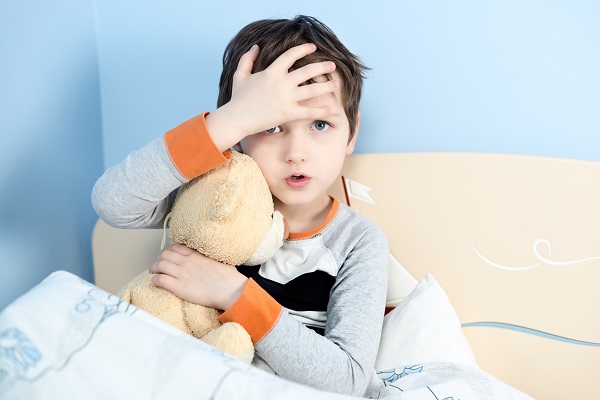As an experienced parent, you may have already encountered your fair share of fevers, coughs, rashes and the like. Or perhaps you’re a new parent, and you weren’t warned of the many common childhood illnesses that can come along with the new gig. As much as we try to protect our children and keep the germs at bay, odds are your child will experience a contagious illness within the first few years of life. Here are a few to look out for:
Hand, foot and mouth disease
Despite the somewhat terrifying name, hand, foot and mouth disease is one of the most common childhood illnesses. Also known as enterovirus, this highly contagious infection affects most kids before age 5. It begins with a three- to six-day incubation period which could include a sore throat and runny nose, much like the common cold. Following the incubation period, a rash usually appears with tiny blisters in the mouth, palms of hand, fingers, soles of feet or on the buttocks.
Hand, foot and mouth disease is a short-term illness that usually lasts only a week. It does not need treatment; but cool liquids can be used to help with sore throats, and acetaminophen or ibuprofen can be given for pain relief. Remember, Aspirin should be avoided in children below 12 years as it may lead to Reye’s syndrome, a life-threatening liver and brain damage syndrome.
This infection can be spread easily through coughing and sneezing and can also be spread through infected stool. Hand, foot and mouth often breaks out in a community. To help prevent the disease from spreading, wash hands frequently, especially after a diaper change or after touching a blister or sore. If your child attends daycare, be sure to talk with daycare staff about a safe return date. Once your child is fever free and no longer has open blisters (it usually takes about seven days for blisters to dry up), he or she should be ready to return to school or daycare.
While adolescents and occasionally adults may also acquire the infection, children are most susceptible. The most common age group of sufferers are children below 10 years. Most adults are immune to the coxsackie A and B virus as they have been previously exposed to it during their childhood. Even if they acquire the infection, it tends to be milder than in children.
Roseola
When it comes to this viral illness, it’s possible your child’s symptoms will be so minor that you won’t even realize he or she is under the weather. However, some kids come down with a high fever, congestion, coughing and, later, a patchy rash that starts on the chest and spreads. Although roseola usually runs its course within a week, contact your pediatrician if your child’s fever spikes or lasts longer than three days. In the meantime, relieve discomfort with children’s ibuprofen and keep your child home until the rash disappears. The good news is this is a generally mild infection that usually affects children by age 2.
Fifth disease
Also known as “slapped cheek syndrome,” fifth disease causes a bright-red rash on the cheeks. Kids ages 3 and under are usually the most vulnerable. Your child may not have any other illness symptoms, though he or she could also have a mild fever, a runny nose, and a secondary, lacy-looking rash on the torso. Fifth disease is highly contagious and often spreads like wildfire through childcare centers and preschools. Once the rash comes out, your child is no longer contagious, and it will subside on its own. A small percentage of kids who get it will develop joint pain. (Let your doctor know right away if this occurs.)
Viral croup
Croup is a condition that causes swelling and irritation of the upper airway most commonly caused by infection. Croup is most common in kids 6 months to 3 years old, but some older children also get croup. Viral croup usually includes symptoms such as runny nose, fever and fatigue. Your child’s voice can become hoarse and his or her breathing will get noisier. There may be a coarse, high-pitched sound each time he or she breathes in, called stridor. Most children with viral croup have a low fever, but some have temperatures up to 104°F (40°C). Symptoms are usually worse at night and when a child is crying or upset.
The virus usually goes away within three to seven days. Most cases are mild and can be treated without medication at home. You can comfort your child by offering reassuring words, hugs and back rubs. If your child has a fever, you can treat with acetaminophen or ibuprofen. Make sure your child is drinking plenty of fluids.
Cough syrups are not recommended and may do more harm than good. A steroid medicine may be prescribed to reduce the swelling. Steroids can be inhaled, taken by mouth or given by injection. Steroids may reduce the intensity of symptoms, the need for other medications, and time spent in the hospital and emergency department. For spasmodic croup, your child’s doctor may recommend allergy or reflux medicines to help your child’s breathing.
RSV
Kids under 2 are most prone to this virus. Respiratory syncytial virus affects the lungs. In most cases, the symptoms are relatively minor and mirror those of a cold. But for newborns and children who have a preexisting conditions such as a congenital heart condition or chronic lung disease, it can quickly become more severe and can lead to either bronchiolitis (an infection of the small airways in the lungs) or pneumonia.
Most childhood illnesses run their course without cause for concern. Some signs or symptoms may call for a visit to your pediatrician. Be sure to look out for:
High fever. If your infant has a fever of 101℉ or higher or your older baby/children have a temperature of 103℉ or higher, you should call your pediatrician.
Dehydration. If you notice sunken eyes (or, for a baby, a sunken fontanel, or soft spot on the head) or extreme lethargy or he or she is sticky or tacky to the touch, your child may be dehydrated. Also beware if urination occurs fewer than three or four times a day.
Trouble breathing. If you notice your child wheezing, breathing fast or labored, or if you notice long pauses between each breath, phone right away.
Not eating. Most sick children do not have an appetite, but if your child is eating or drinking less than half of what he or she normally would for two days or longer, check with your doctor.
Preexisting conditions. If your child has been diagnosed with asthma, diabetes, a suppressed immune system or another chronic medical condition, speak to your pediatrician every time he or she comes down with a virus that could compromise health.
Remember, if you think your child might be ill or injured, don’t take a chance! Come to the emergency department, and we’ll assess your child’s health as fast as possible. For any other pediatric needs, call 706-721-KIDS (5437) to schedule an appointment or visit augustahealth.org/chog to learn more.
Source: American Academy of Pediatrics




